2014 Hyundai Santa Fe seat belts
[x] Cancel search: seat beltsPage 26 of 711
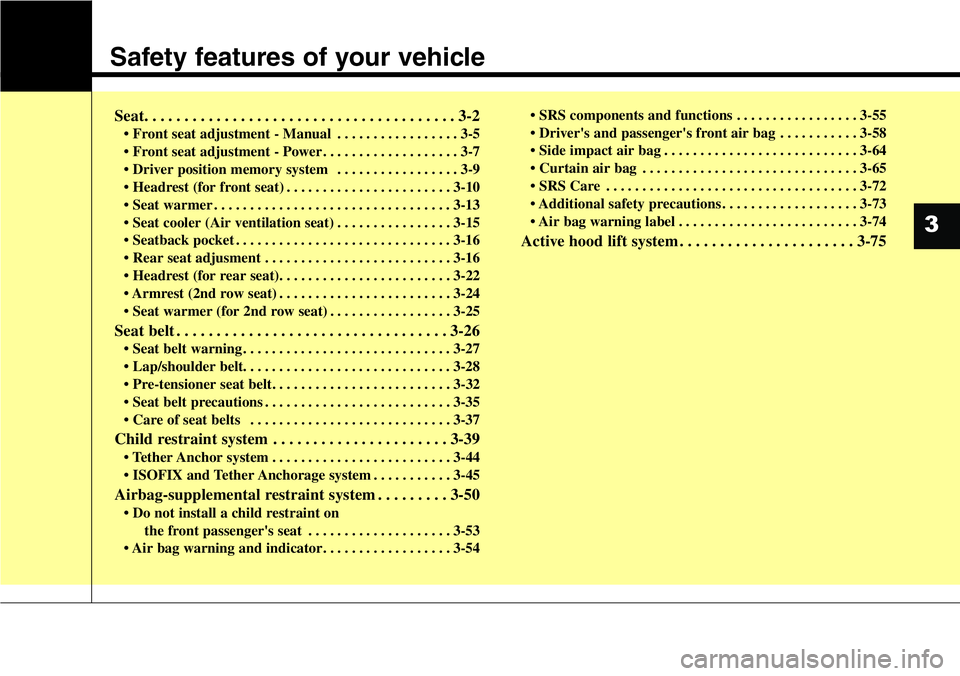
Safety features of your vehicle
Seat. . . . . . . . . . . . . . . . . . . . . . . . . . . . . . . . . . . . . . . 3-2
• Front seat adjustment - Manual . . . . . . . . . . . . . . . . . 3-5
• Front seat adjustment - Power . . . . . . . . . . . . . . . . . . . 3-7
• Driver position memory system . . . . . . . . . . . . . . . . . 3-9
• Headrest (for front seat) . . . . . . . . . . . . . . . . . . . . . . . 3-10
• Seat warmer . . . . . . . . . . . . . . . . . . . . . . . . . . . . . . . . . 3-13
• Seat cooler (Air ventilation seat) . . . . . . . . . . . . . . . . 3-15
• Seatback pocket . . . . . . . . . . . . . . . . . . . . . . . . . . . . . . 3-16
• Rear seat adjusment . . . . . . . . . . . . . . . . . . . . . . . . . . 3-16
• Headrest (for rear seat). . . . . . . . . . . . . . . . . . . . . . . . 3-22
• Armrest (2nd row seat) . . . . . . . . . . . . . . . . . . . . . . . . 3-24
• Seat warmer (for 2nd row seat) . . . . . . . . . . . . . . . . . 3-25
Seat belt . . . . . . . . . . . . . . . . . . . . . . . . . . . . . . . . . . 3-26
• Seat belt warning . . . . . . . . . . . . . . . . . . . . . . . . . . . . . 3-27
• Lap/shoulder belt. . . . . . . . . . . . . . . . . . . . . . . . . . . . . 3-28
• Pre-tensioner seat belt. . . . . . . . . . . . . . . . . . . . . . . . . 3-32
• Seat belt precautions . . . . . . . . . . . . . . . . . . . . . . . . . . 3-35
• Care of seat belts . . . . . . . . . . . . . . . . . . . . . . . . . . . . 3-37
Child restraint system . . . . . . . . . . . . . . . . . . . . . . 3-39
• Tether Anchor system . . . . . . . . . . . . . . . . . . . . . . . . . 3-44
• ISOFIX and Tether Anchorage system . . . . . . . . . . . 3-45
Airbag-supplemental restraint system . . . . . . . . . 3-50
• Do not install a child restraint on
the front passenger's seat . . . . . . . . . . . . . . . . . . . . 3-53
• Air bag warning and indicator. . . . . . . . . . . . . . . . . . 3-54• SRS components and functions . . . . . . . . . . . . . . . . . 3-55
• Driver's and passenger's front air bag . . . . . . . . . . . 3-58
• Side impact air bag . . . . . . . . . . . . . . . . . . . . . . . . . . . 3-64
• Curtain air bag . . . . . . . . . . . . . . . . . . . . . . . . . . . . . . 3-65
• SRS Care . . . . . . . . . . . . . . . . . . . . . . . . . . . . . . . . . . . 3-72
• Additional safety precautions . . . . . . . . . . . . . . . . . . . 3-73
• Air bag warning label . . . . . . . . . . . . . . . . . . . . . . . . . 3-74
Active hood lift system . . . . . . . . . . . . . . . . . . . . . . 3-753
Page 42 of 711
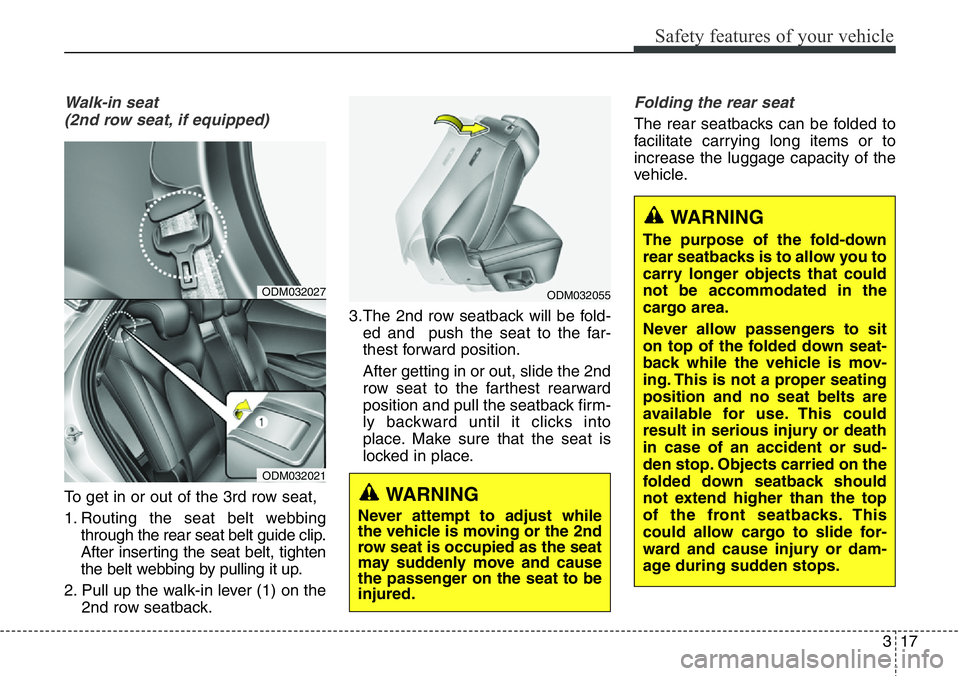
317
Safety features of your vehicle
Walk-in seat
(2nd row seat, if equipped)
To get in or out of the 3rd row seat,
1. Routing the seat belt webbing
through the rear seat belt guide clip.
After inserting the seat belt, tighten
the belt webbing by pulling it up.
2. Pull up the walk-in lever (1) on the
2nd row seatback.3.The 2nd row seatback will be fold-
ed and push the seat to the far-
thest forward position.
After getting in or out, slide the 2nd
row seat to the farthest rearward
position and pull the seatback firm-
ly backward until it clicks into
place. Make sure that the seat is
locked in place.
Folding the rear seat
The rear seatbacks can be folded to
facilitate carrying long items or to
increase the luggage capacity of the
vehicle.
ODM032055
WARNING
The purpose of the fold-down
rear seatbacks is to allow you to
carry longer objects that could
not be accommodated in the
cargo area.
Never allow passengers to sit
on top of the folded down seat-
back while the vehicle is mov-
ing. This is not a proper seating
position and no seat belts are
available for use. This could
result in serious injury or death
in case of an accident or sud-
den stop. Objects carried on the
folded down seatback should
not extend higher than the top
of the front seatbacks. This
could allow cargo to slide for-
ward and cause injury or dam-
age during sudden stops.
WARNING
Never attempt to adjust while
the vehicle is moving or the 2nd
row seat is occupied as the seat
may suddenly move and cause
the passenger on the seat to be
injured.
ODM032027
ODM032021
Page 46 of 711

321
Safety features of your vehicle
WARNING - 2nd row cen-
ter seat fold-
ing
• Do not fold the 2nd row center
seat, if the occupants in the
3rd row seats, It may cause
the injury to occupants by the
seat device.
If occupants in the 3rd row
seats, Fix the upright position
of the 2nd row center seat.
• The 2nd row center seat back
does not fix when it is folded.
If you use the 2nd row center
seat back folding function to
carry long objects, you should
fix the long object to prevent it
from being thrown about the
vehicle in a collision and
causing injury to vehicle
occupants.
CAUTION- Rear seat belts
When returning the rear (2nd
and/or 3rd row) seatbacks to the
upright position, remember to
return the rear shoulder belts to
their proper position. Routing the
seat belt webbing through the
rear seat belt guides will help
keep the belts from being trapped
behind or under the seats.
CAUTION - Damaging
rear seat belt buckles
When you fold the rear (2nd
and/or 3rd row) seatback, insert
the buckle in the pocket between
the rear seatback and cushion.
Doing so can prevent the buckle
from being damaged by the rear
seatback.
WARNING - Uprighting
seat
When you return the seatback
to its upright position, hold the
seatback and return it slowly. If
the seatback is returned with-
out holding it, the back of the
seat could spring forward
resulting in injury caused by
being struck by the seatback.
Page 51 of 711
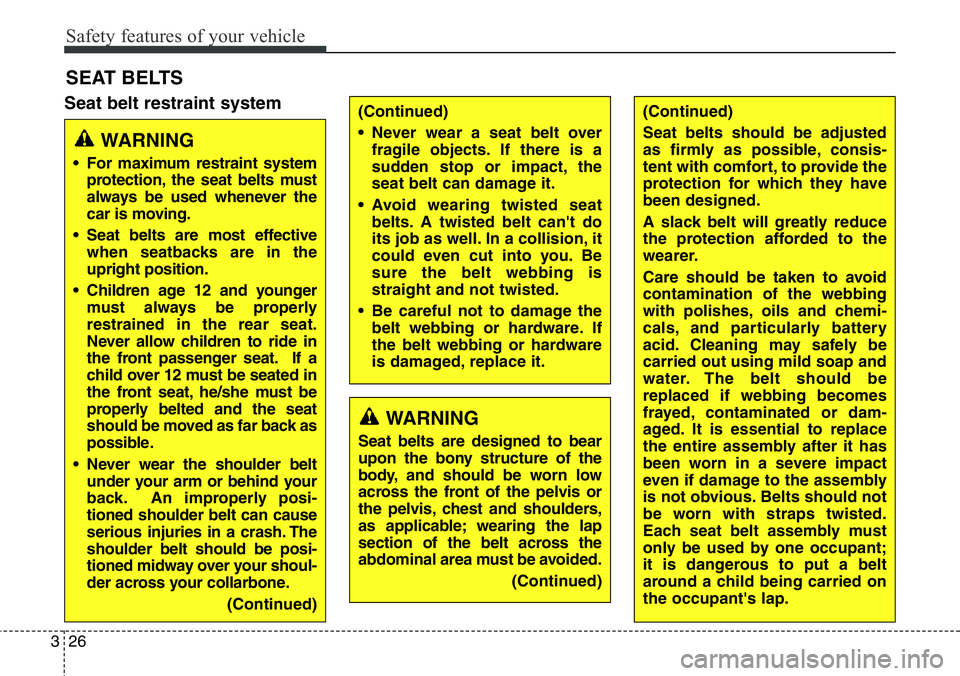
Safety features of your vehicle
26 3
Seat belt restraint system
SEAT BELTS
(Continued)
• Never wear a seat belt over
fragile objects. If there is a
sudden stop or impact, the
seat belt can damage it.
• Avoid wearing twisted seat
belts. A twisted belt can't do
its job as well. In a collision, it
could even cut into you. Be
sure the belt webbing is
straight and not twisted.
• Be careful not to damage the
belt webbing or hardware. If
the belt webbing or hardware
is damaged, replace it.
WARNING
Seat belts are designed to bear
upon the bony structure of the
body, and should be worn low
across the front of the pelvis or
the pelvis, chest and shoulders,
as applicable; wearing the lap
section of the belt across the
abdominal area must be avoided.
(Continued)
WARNING
• For maximum restraint system
protection, the seat belts must
always be used whenever the
car is moving.
• Seat belts are most effective
when seatbacks are in the
upright position.
• Children age 12 and younger
must always be properly
restrained in the rear seat.
Never allow children to ride in
the front passenger seat. If a
child over 12 must be seated in
the front seat, he/she must be
properly belted and the seat
should be moved as far back as
possible.
• Never wear the shoulder belt
under your arm or behind your
back. An improperly posi-
tioned shoulder belt can cause
serious injuries in a crash. The
shoulder belt should be posi-
tioned midway over your shoul-
der across your collarbone.
(Continued)
(Continued)
Seat belts should be adjusted
as firmly as possible, consis-
tent with comfort, to provide the
protection for which they have
been designed.
A slack belt will greatly reduce
the protection afforded to the
wearer.
Care should be taken to avoid
contamination of the webbing
with polishes, oils and chemi-
cals, and particularly battery
acid. Cleaning may safely be
carried out using mild soap and
water. The belt should be
replaced if webbing becomes
frayed, contaminated or dam-
aged. It is essential to replace
the entire assembly after it has
been worn in a severe impact
even if damage to the assembly
is not obvious. Belts should not
be worn with straps twisted.
Each seat belt assembly must
only be used by one occupant;
it is dangerous to put a belt
around a child being carried on
the occupant's lap.
Page 54 of 711

329
Safety features of your vehicle
✽NOTICE
If you are not able to pull out the
seat belt from the retractor, firmly
pull the belt out and release it. Then
you will be able to pull the belt out
smoothly.
Height adjustment
You can adjust the height of the shoul-
der belt anchor to one of 4 positions
for maximum comfort and safety.
If the height of the seat belt is too
near your neck, you will not be get-
ting the most effective protection.
The shoulder portion should be
adjusted so that it lies across your
chest and midway over your shoulder
nearest the door and not your neck.
To adjust the height of the seat belt
anchor, lower or raise the height
adjuster into an appropriate position.To raise the height adjuster, pull it up
(1). To lower it, push it down (3) while
pressing the height adjuster button (2).
Release the button to lock the
anchor into position. Try sliding the
height adjuster to make sure that it
has locked into position.
OCM030026
Front seat
WARNING
• Verify the shoulder belt
anchor is locked into position
at the appropriate height.
Never position the shoulder
belt across your neck or face.
Improperly positioned seat
belts can cause serious
injuries in an accident.
• Failure to replace seat belts
after an accident could leave
you with damaged seat belts
that will not provide protec-
tion in the event of another
collision leading to personal
injury or death. Replace your
seat belts after being in an
accident as soon as possible.
Page 56 of 711
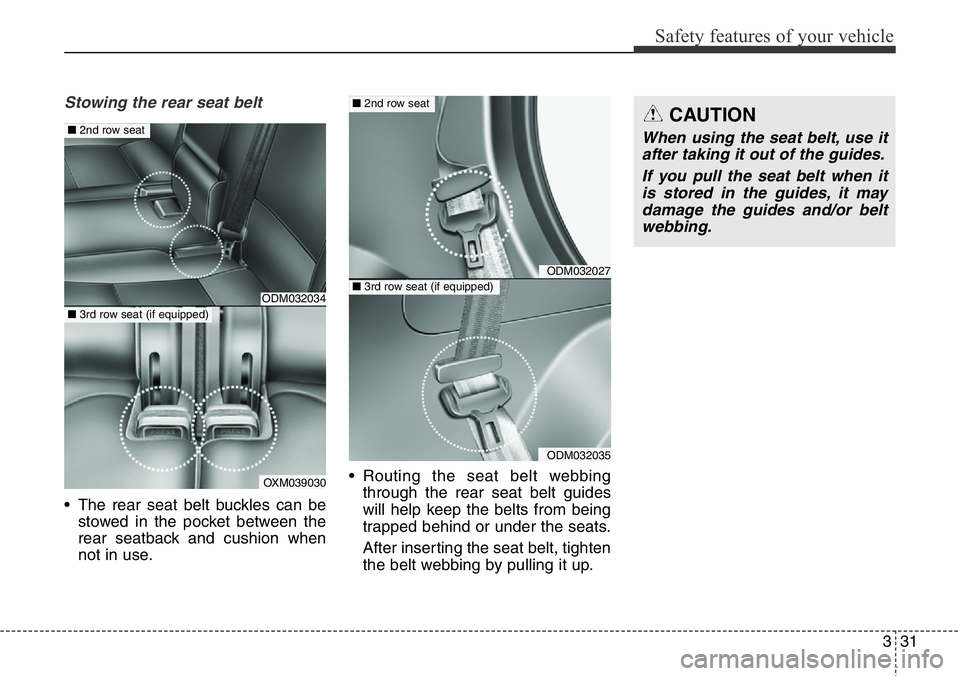
331
Safety features of your vehicle
Stowing the rear seat belt
• The rear seat belt buckles can be
stowed in the pocket between the
rear seatback and cushion when
not in use.• Routing the seat belt webbing
through the rear seat belt guides
will help keep the belts from being
trapped behind or under the seats.
After inserting the seat belt, tighten
the belt webbing by pulling it up.
ODM032034
OXM039030
■2nd row seat
■3rd row seat (if equipped)
ODM032027
ODM032035
■2nd row seat
■3rd row seat (if equipped)
CAUTION
When using the seat belt, use it
after taking it out of the guides.
If you pull the seat belt when it
is stored in the guides, it may
damage the guides and/or belt
webbing.
Page 57 of 711
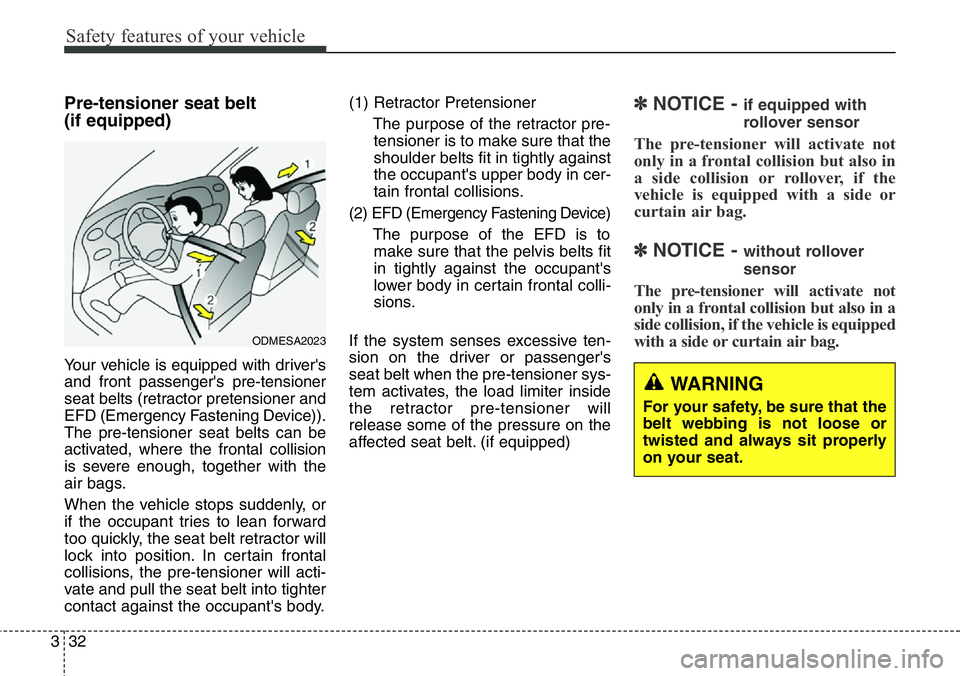
Safety features of your vehicle
32 3
Pre-tensioner seat belt
(if equipped)
Your vehicle is equipped with driver's
and front passenger's pre-tensioner
seat belts (retractor pretensioner and
EFD (Emergency Fastening Device)).
The pre-tensioner seat belts can be
activated, where the frontal collision
is severe enough, together with the
air bags.
When the vehicle stops suddenly, or
if the occupant tries to lean forward
too quickly, the seat belt retractor will
lock into position. In certain frontal
collisions, the pre-tensioner will acti-
vate and pull the seat belt into tighter
contact against the occupant's body.(1) Retractor Pretensioner
The purpose of the retractor pre-
tensioner is to make sure that the
shoulder belts fit in tightly against
the occupant's upper body in cer-
tain frontal collisions.
(2) EFD (Emergency Fastening Device)
The purpose of the EFD is to
make sure that the pelvis belts fit
in tightly against the occupant's
lower body in certain frontal colli-
sions.
If the system senses excessive ten-
sion on the driver or passenger's
seat belt when the pre-tensioner sys-
tem activates, the load limiter inside
the retractor pre-tensioner will
release some of the pressure on the
affected seat belt. (if equipped)
✽NOTICE - if equipped with
rollover sensor
The pre-tensioner will activate not
only in a frontal collision but also in
a side collision or rollover, if the
vehicle is equipped with a side or
curtain air bag.
✽NOTICE - without rollover
sensor
The pre-tensioner will activate not
only in a frontal collision but also in a
side collision, if the vehicle is equipped
with a side or curtain air bag.
ODMESA2023
WARNING
For your safety, be sure that the
belt webbing is not loose or
twisted and always sit properly
on your seat.
Page 58 of 711
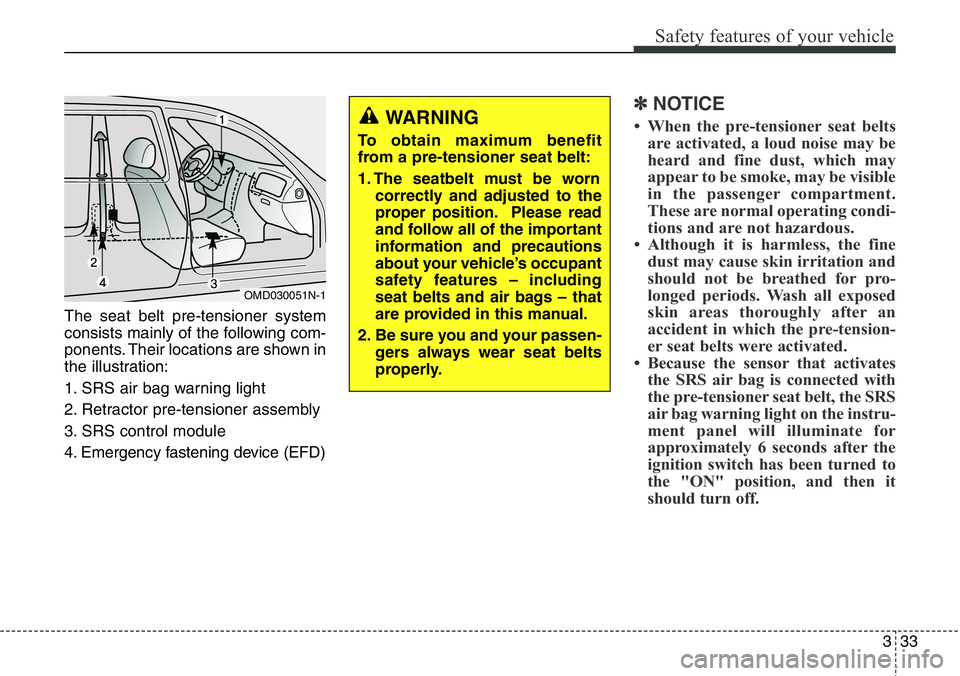
333
Safety features of your vehicle
The seat belt pre-tensioner system
consists mainly of the following com-
ponents. Their locations are shown in
the illustration:
1. SRS air bag warning light
2. Retractor pre-tensioner assembly
3. SRS control module
4. Emergency fastening device (EFD)
✽NOTICE
• When the pre-tensioner seat belts
are activated, a loud noise may be
heard and fine dust, which may
appear to be smoke, may be visible
in the passenger compartment.
These are normal operating condi-
tions and are not hazardous.
• Although it is harmless, the fine
dust may cause skin irritation and
should not be breathed for pro-
longed periods. Wash all exposed
skin areas thoroughly after an
accident in which the pre-tension-
er seat belts were activated.
• Because the sensor that activates
the SRS air bag is connected with
the pre-tensioner seat belt, the SRS
air bag warning light on the instru-
ment panel will illuminate for
approximately 6 seconds after the
ignition switch has been turned to
the "ON" position, and then it
should turn off.WARNING
To obtain maximum benefit
from a pre-tensioner seat belt:
1. The seatbelt must be worn
correctly and adjusted to the
proper position. Please read
and follow all of the important
information and precautions
about your vehicle’s occupant
safety features – including
seat belts and air bags – that
are provided in this manual.
2. Be sure you and your passen-
gers always wear seat belts
properly.
OMD030051N-1